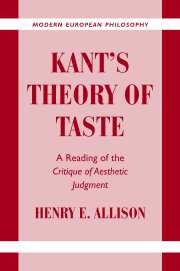Book contents
- Frontmatter
- Contents
- Acknowledgments
- Note on Sources and Key to Abbreviations and Translations
- Introduction
- PART I KANT'S CONCEPTION OF REFLECTIVE JUDGMENT
- PART II THE QUID FACTI AND THE QUID JURIS IN THE DOMAIN OF TASTE
- PART III THE MORAL AND SYSTEMATIC SIGNIFICANCE OF TASTE
- 9 Reflective Judgment and the Transition from Nature to Freedom
- 10 Beauty, Duty, and Interest: The Moral Significance of Natural Beauty
- 11 The Antinomy of Taste and Beauty as a Symbol of Morality
- PART IV PARERGA TO THE THEORY OF TASTE
- Notes
- Bibliography
- Index
11 - The Antinomy of Taste and Beauty as a Symbol of Morality
Published online by Cambridge University Press: 18 January 2010
- Frontmatter
- Contents
- Acknowledgments
- Note on Sources and Key to Abbreviations and Translations
- Introduction
- PART I KANT'S CONCEPTION OF REFLECTIVE JUDGMENT
- PART II THE QUID FACTI AND THE QUID JURIS IN THE DOMAIN OF TASTE
- PART III THE MORAL AND SYSTEMATIC SIGNIFICANCE OF TASTE
- 9 Reflective Judgment and the Transition from Nature to Freedom
- 10 Beauty, Duty, and Interest: The Moral Significance of Natural Beauty
- 11 The Antinomy of Taste and Beauty as a Symbol of Morality
- PART IV PARERGA TO THE THEORY OF TASTE
- Notes
- Bibliography
- Index
Summary
Our present concern is with Kant's conception of beauty as a symbol of morality and its significance for both taste and morality. But since the section in which Kant articulates this doctrine (§59) constitutes the completion of the Dialectic of Aesthetic Judgment, it will be necessary to consider the argument of the Dialectic in some detail. This will not amount to a digression from the main purpose of this portion of our study, however, since we shall see that the problem Kant takes up in the Dialectic (the formulation and resolution of an antinomy of taste) is itself intimately related to the general problem of the systematic and moral significance of taste. In particular, it marks a return to themes set forth in Section IX of the Second Introduction, which were discussed in Chapter 9.
The chapter is divided into six parts. The first analyzes Kant's account of the nature of the antinomy of taste and tries to show that, contrary to some interpretations, he is there concerned with a genuine and fresh problem. The second and third parts deal with the account of the resolution of the antinomy in §57 and the comments attached to that section. The former discusses what might be termed the “formal” resolution through the clarification of the sense of “concept” appealed to by both parties, and the latter the problematic and much-criticized appeal to the supersensible that Kant makes on the basis of this resolution. The fourth part analyzes the actual account of beauty as a symbol of morality, which it interprets in light of Kant's conception of aesthetic ideas.
- Type
- Chapter
- Information
- Kant's Theory of TasteA Reading of the Critique of Aesthetic Judgment, pp. 236 - 268Publisher: Cambridge University PressPrint publication year: 2001

